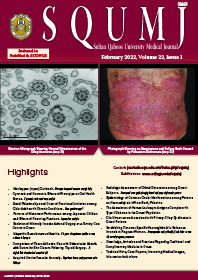Main Article Content
Abstract
Objectives: This study aimed to determine the orbital dimensions of Omani subjects who had been referred for computed tomography (CT) of the brain at Sultan Qaboos University Hospital, Muscat, Oman. Good knowledge of the normal orbital dimensions is clinically essential for successful surgical outcomes. Racial, ethnic and regional variations in the orbital dimensions have been reported. Methods: A total of 273 Omani patients referred for CT scans of the brain were retrospectively evaluated using an electronic medical records database. The orbital dimensions were recorded using both axial and sagittal planes of CT images. Results: The mean orbital index (OI) was found to be 83.25 ± 4.83 mm and the prevalent orbital type was categorised as the mesoseme. The mean orbital index was 83.34 ± 5.05 mm and 83.16 ± 4.57 mm in males and females, respectively, with their difference not being statistically significant (P = 0.76). However, a statistically significant association was observed between the right and left orbits regarding horizontal distance (P <0.05) and vertical distance (P <0.01) of orbit and OI (P <0.05). No significant difference between the OI and age groups was observed in males and females. The mean interorbital distance and interzygomatic distance were found to be 19.45 ± 1.52 mm and 95.59 ± 4.08 mm, respectively. These parameters were significantly higher in males (P <0.05). Conclusion: Results of the present study provide reference values of orbital dimensions in Omani subjects. Mesoseme, a hallmark of Caucasian people, is discovered to be the prevalent orbital type of Omani subjects.
Keywords: Computed tomography; Ethnicity; Orbit; Biological Variation; Hypertelorism; Oman.
Article Details

This work is licensed under a Creative Commons Attribution-NoDerivatives 4.0 International License.
